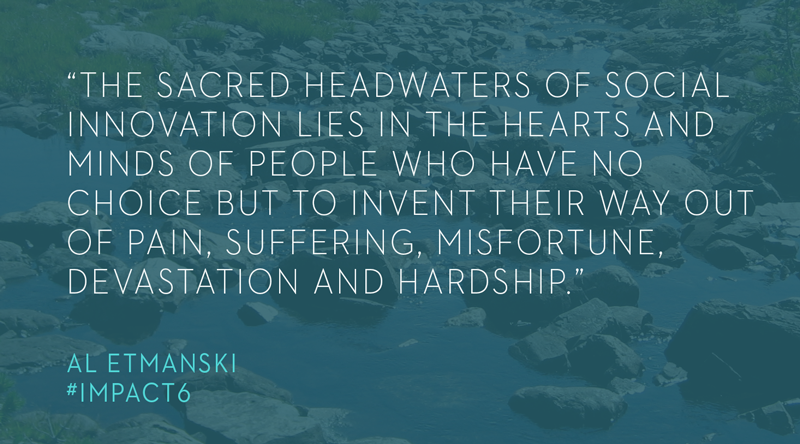The following piece is adapted from a blog essay I wrote for Social Innovation Exchange (SIX). SIX is a global curator of social innovation. They are issuing a series of blogs on peacemaking in advance of their annual Summit which will be held October 5th – 7th in Columbia. Their theme: Social Innovation in Divided Societies.
Just as one tree standing alone would soon be destroyed by the first strong wind which came along, so it is impossible for any person, any family, or any community to stand alone against the troubles of this world.
— Haida Chief Skidegate, Lewis Collinson
Everything I’ve read about social innovation and resilience I have found alive and well among Indigenous people in Canada. They are innovating themselves back from attempts at genocide, cultural extinction, residential schools, land grabs, segregation, addiction and racism to cultural, social and economic self -sufficiency. If that’s not the elusive staying power the social innovation community seeks I don’t know what is.
In particular, Indigenous people are teaching us that peacemaking is the necessary link between adversity and ingenuity. That the sacred headwaters of social innovation lies in the hearts and minds of people who have no choice but to invent their way out of pain, suffering, misfortune, devastation and hardship. Further, that peacemaking is the core value, essential mindset and pre-eminent practice to ensure that social innovation will spread and endure.
For 400 years Indigenous people welcomed successive waves of settlers to the upper half of North America. These newcomers would not have survived in our adverse climate and rugged habitat without Indigenous hospitality and expertise.
The Indigenous concept of inclusion leaves room for multiple identities and loyalties. It sees no contradiction between diversity and fairness. It imagines belonging as an inclusive circle that continuously expands regardless of where you have come from and adapts to changing circumstances. It seeks balance between place, group and individual.
Tragically, explorers, settlers and their descendants often betrayed their welcome. The opening quote is by a former chief of the Haida Gwaii community of Skidegate. If anyone had a reason for mistrust and hostility toward newcomers, Chief Lewis Collinson did. Europeans decimated his nation. At the time of contact, the Haida population was in the tens of thousands. That number fell to less than five hundred by the early 1900s. The majority of people died of diseases such as smallpox and tuberculosis that were introduced by traders.
Today the Haida population has grown to twenty-five hundred. Haida culture is revived. Its artists, poets and storytellers are known around the world. Children are learning their native language. Young adults eagerly train to become Haida Gwaii Watchmen, responsible for protecting their cultural heritage in the abandoned villages of their ancestors. A large chunk of the Haida archipelago is set aside as Gwaii Haanas, a national park reserve and world heritage site that the Haida Nation co-manages with the federal government. The latter (Gwaii Haanas Agreement) is the only example I’ve encountered of enshrining paradox in a governance agreement. It’s brilliant.
The Haida Nation’s remarkable recovery is due to many factors. One is the peacemaking mindset reflected in Chief Lewis Collinson’s remarks. He, like most Indigenous leaders, understands that the future well-being of Indigenous people is dependent on the future well-being of all Canadians. The reverse is also true as we are slowly learning.
Coupled with Indigenous people’s discipline, strategic prowess and creative capability is an understanding that we inhabit the same bewildered and besieged land. And that we must engage with people who have betrayed us or who we have betrayed; who we are suspicious of or don’t like; who aren’t pulling their weight or who, we are convinced, are responsible for our messy challenges. And the only way that can happen is by making peace among all inhabitants.
EH!
Social innovation is not just new ways to fix old problems. It’s bringing old ways forward into a new context. (Senator Murray Sinclair, Chair Truth and Reconciliation Commission)
Musical accompaniment this post is Power in the Blood by Buffy Sainte-Marie. Purchase here.
A Marriage of Playground and Podium

One Comment
Carl
Loved this content Al, very well-written and informative! Thank you for sharing.
What the world needs now, more than ever, is peace. If we can only find it in our hearts to fight for it regardless of the outcome, then the quest for peace has already begun. Check this out What Is Peace-making and Why Does It Matter? Hope this will help. Thank you.